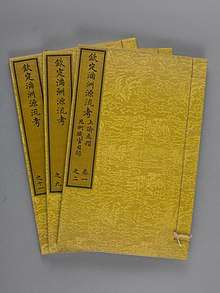Researches on Manchu Origins
Researches on Manchu Origins, also known as Manzhou Yuanliu Kao, is an important history book published by the Qing Dynasty government in 1777. The Qianlong Emperor sponsored its compilation with the goal of legitimizing Qing rule, as well as identifying the Qing as a successor to the Jin Dynasty (1115–1234).[1] The Manzhou Yuanliu Kao also bolstered Qianlong's conception of the Manchu people as a wu, or martial race.[2]
| Researches on Manchu Origins | |||||||
|---|---|---|---|---|---|---|---|
 | |||||||
| Chinese name | |||||||
| Traditional Chinese | 滿洲源流考 | ||||||
| Simplified Chinese | 满洲源流考 | ||||||
| |||||||
| Mongolian name | |||||||
| Mongolian Cyrillic | ᠮᠠᠨᠵᠢᠢᠨ ᠭᠠᠷᠠᠯ ᠦᠦᠰᠯᠢᠢᠨ ᠲᠠᠯᠠᠠᠷᠺᠬᠢ ᠰᠦᠳᠠᠯᠭᠠᠠ | ||||||
| |||||||
| Manchu name | |||||||
| Manchu script | ᠮᠠᠨᠵᡠᠰᠠᡳ ᡩᠠ ᠰᡝᡴᡳᠶᡝᠨ ᡳ ᡴᡳᠮᠴᡳᠨ ᠪᡳᡨᡥᡝ | ||||||
| Abkai | Manjusai da sekiyen-i kimqin bithe | ||||||
| Möllendorff | Manjusai da sekiyen-i kimcin bithe | ||||||
It consists of 4 parts: Manchu tribes, territory, topography (mountains and rivers), and culture. Pamela Kyle Crossley analyses it as the apex of the Qing Dynasty's attempt at "documentary institutionalisation" of Manchu heritage and from it, Manchu ethnic identity.[3] Researches on Manchu Origins contained a list of corrections of transcribed Jurchen language words found in the History of Jin in Chapter 135, using the Manchu language to correct them, in Chapter 18.[4]
References
- Smith, Richard (2015). The Qing Dynasty and Traditional Chinese Culture. Rowman & Littlefield. p. 80.
- Roy, Kaushik; Lorge, Peter (2014). Chinese and Indian Warfare – From the Classical Age to 1870. Routledge. p. 231.
- Crossley, Pamela Kyle (November 1987). "Manzhou yuanliu kao and the Formalization of the Manchu Heritage". Journal of Asian Studies. 46 (4). JSTOR 2057101.
- 金史/卷135 滿洲源流考/卷18 Archived 2016-10-08 at the Wayback Machine
- Huang, Pei (1990). "New Light on The Origins of The Manchus". Harvard Journal of Asiatic Studies. 50 (1): 239–282. doi:10.2307/2719229. JSTOR 2719229.